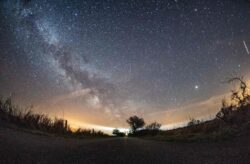One of the year’s most spectacular meteor showers is about to get underway (Picture: Getty Images/iStockphoto)
Of all the meteor showers that occur in the year, the Orionids is one of the best known and most spectacular.
On good years, up to 25 shooting stars can be spotted every hour as they blaze across the night sky.
You don’t need any special equipment to enjoy the meteor shower, just a good viewing spot, a little patience and – hopefully – good weather conditions.
Many people consider the Orionids the best meteor shower because the tiny chunks of rock that burn up in our atmosphere are actually fragments from Halley’s comet – one of the most famous comets there is.
Halley’s comet is visible from Earth every 76 years. It was last seen in our skies in 1986 and won’t come round for another pass until 2061. It’s been viewed and recorded by astronomers since at least 240BC.
Even if you haven’t seen Halley’s comet for yourself, you’ll get to see parts of it if you stay up and watch the Orionids this week.
The Orionids meteor shower will peak this week, giving you the best chance to spot some shooting stars (Credits: Getty Images)
‘The Orionids, which peak during mid-October each year, are considered to be one of the most beautiful showers of the year,’ explained Nasa.
‘Orionid meteors are known for their brightness and for their speed. These meteors are fast—they travel at about 148,000 mph (66 km/s) into the Earth’s atmosphere.
‘Fast meteors can leave glowing “trains” (incandescent bits of debris in the wake of the meteor) which last for several seconds to minutes. Fast meteors can also sometimes become fireballs.’
As both the Earth and Halley’s comet have elliptical orbits around the sun, the two intersect twice every year, causing not only the Orionids, but also the Eta Aquariid meteor shower in May.
What time do the Orionids peak over the UK in 2022?
You’ll need to be outside and looking up on Thursday night (Getty Images)
This year, the Orionids will reach its peak on Thursday, Friday and Saturday nights.
That’s the 20th, 21st and 22nd of October, 2022.
Your best chance to see it will be between midnight and dawn.
This year, weather conditions aren’t as favourable so there may be less visible meteors than in previous years.
The Royal Observatory Greenwich has advised you may see up to 15 meteors per hour this year.
However, the moon will be just a sliver this year so you won’t have to content with moonlight spoiling the show.
How long does the Orionids meteor shower stay visible for?
The Orionids Meteor Shower peaks tonight but will be visible until November 7 (Credits: Shutterstock / Brian Spencer)
The good news is that the Orionids aren’t just visible over their peak, but for quite a long time afterwards as well.
The shower should remain visible in both northern and southern hemispheres until around November 7.
So, if you get a clear night between now and then – it could well be worth wrapping up warm and heading out for another chance to spot the shooting stars.
When and where to look to see the Orionids meteor shower
Skywatchers across the UK will be able to see the shower (Credits: Getty Images)
After sunset the meteors could start to become visible, but your best chance to see them will be after 10pm. The official ‘peak time’ for spotting meteors is around midnight.
You will need to look upwards and eastwards into the night sky – near the constellation of Orion – for the best chance of spotting the meteors.
Anna Ross, an astronomer at the Royal Observatory Greenwich, explained: ‘Meteors will be visible all over the sky but they will appear to originate from close to the star Betelgeuse in the constellation of Orion, which will be in the east of the sky during that peak time.
As ever, the best way to see them is to get as far away from light pollution as possible and just look upwards.
You’ll need to spend some time, around 15 minutes or so, letting your eyes adjust to the darkness.
A guide on where to look to see the Orionids (Picture: PA)
What causes the Orionids meteor shower?
Halley’s Comet as seen in 1986 (Picture: Flickr/ Lucas)
The Orionids are caused by the Earth’s orbit bringing it into contact with debris from Halley’s comet.
Halley takes around 76 years to make a complete revolution around the Sun. It will next be visible from Earth in 2061.
Nasa explained: ‘Each time that Halley returns to the inner solar system its nucleus sheds ice and rocky dust into space. The dust grains eventually become the Orionids in October and the Eta Aquarids in May if they collide with Earth’s atmosphere.’
The cometary debris enters our planet’s atmosphere at speeds of around 41 miles per second, vaporising from friction with the air causing the streaks of light we call meteors.
MORE : Nasa records the first ‘bloop’ sounds of meteorites striking Mars
MORE : Giant meteorite impacts are what created the continents, say scientists
Wrap up warm this weekend for one of the best meteor showers of the year.





